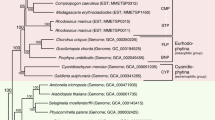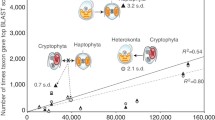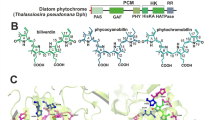Abstract
Phycobiliproteins, together with linker polypeptides and various chromophores, are basic building blocks of phycobilisomes, a supramolecular complex with a light-harvesting function in cyanobacteria and red algae. Previous studies suggest that the different types of phycobiliproteins and the linker polypeptides originated from the same ancestor. Here we retrieve the phycobilisome-related genes from the well-annotated and even unfinished cyanobacteria genomes and find that many sites with elevated d N /d S ratios in different phycobiliprotein lineages are located in the chromophore-binding domain and the helical hairpin domains (X and Y). Covariation analyses also reveal that these sites are significantly correlated, showing strong evidence of the functional-structural importance of interactions among these residues. The potential selective pressure driving the diversification of phycobiliproteins may be related to the phycobiliprotein-chromophore microenvironment formation and the subunits interaction. Sites and genes identified here would provide targets for further research on the structural-functional role of these residues and energy transfer through the chromophores.





Similar content being viewed by others
References
Adir N, Lerner N (2003) The crystal structure of a novel unmethylated form of C-phycocyanin, a possible connector between cores and rods in phycobilisomes. J Biol Chem 278:25926–25932
Afonnikov DA, Kolchanov NA (2004) CRASP: a program for analysis of coordinated substitutions in multiple alignments of protein sequences. Nucleic Acids Res 32: W64–W68
Apt KE, Collier JL, Grossman AR (1995) Evolution of the phycobiliproteins. J Mol Biol 248:79–96
Atchley WR, Wollenberg KR, Fitch WM, Terhalle W, Dress AW (2000) Correlations among amino acid sites in bHLH protein domains: an information theoretic analysis. Mol Biol Evol 17:164–178
Bickel PJ, Kechris KJ, Spector PC, Wedemayer GJ, Glazer AN (2002) Finding important sites in protein sequences. Proc Natl Acad Sci USA 99:14764–14771
Borisov AY (1989) Transfer of excitation energy in photosynthesis: some thoughts. Photosynth Res 20:35–38
Brejc K, Ficner R, Huber R, Steinbacher S (1995) Isolation, crystallization, crystal structure analysis and refinement of allophycocyanin from the cyanobacterium Spirulina platensis at 2.3 Å resolution. J Mol Biol 249:424–440
Bryant DA (1982) Phycoerythrocyanin and phycoerythrin: properties and occurrence in cyanobacteria. J Gen Microbiol 128:835–844
Bryant DA (1991) Cyanobacterial phycobilisomes: Progress toward complete structure and function in the cyanobacterium Synechococcus sp. PCC 7002. In: Bogorad L, Vasil K (eds) The photosynthetic apparatus: molecular biology and operation. Academic Press, Boston, pp 257–300
Creevey CJ, McInerney JO (2002) An algorithm for detecting directional and non-directional positive selection, neutrality and negative selection in protein coding DNA sequences. Gene 300:43–51
Doust AB, Marai CN, Harrop SJ, Wilk KE, Curmi PM, Scholes GD (2004) Developing a structure-function model for the cryptophyte phycoerythrin 545 using ultrahigh resolution crystallography and ultrafast laser spectroscopy. J Mol Biol 344:135–153
Ducret A, Sidler W, Frank G, Zuber H (1994) Complete amino acid sequence of R-phycocyanin I alpha- and beta-subunits from the red alga Porphyridium cruentum. Eur J Biochem 221:563–580
Duerring M, Huber R, Bode W, Ruembeli R, Zuber H (1990) Refined three-dimensional structure of phycoerythrocyanin from the cyanobacterium Mastigocladus laminosus at 2.7 Å. J Mol Biol 211:633–644
Felsenstein J, (1989) Phylogeny inference package (version 3.2). Cladistics 5:164–166
Ficner R, Lobeck K, Schmidt G, Huber R (1992) Isolation, crystallization, crystal structure analysis and refinement of B-phycoerythrin from the red alga Porphyridium sordidum at 2.2 Å resolution. J Mol Biol 228:935–950
Glauser M, Stirewalt VI, Bryant DA, Sidler W, Zuber H (1992) Structures of the genes encoding the rod-core linker polypeptides of Mastigocladus laminosus phycobilisomes and functional aspects of the phycobiliprotein/linker-polypeptide interactions. Eur J Biochem 205:927–973
Glazer AN (1980) Structure and evolution of photosynthetic accessory pigment systems with special reference to phycobiliproteins. In: Sigman DS, Brazier MAB (eds) The evolution of protein structure and function. Academic Press, New York, pp 221–244
Glazer AN (1988) Phycobilisomes. Methods Enzymol 167:304–312
Henikoff S, Henikoff JG (1994) Position-based sequence weights. J Mol Biol 243:574–578
Huber R, (1989) A structural basis of light energy electron transfer in biology. EMBO J 8:2125–2147
Kikuchi H, Wako H, Yura K, Go M, Mimuro M (2000) Significance of a two-domain structure in subunits of phycobiliproteins revealed by the normal mode analysis. Biophys J 79:1587–1600
MacColl R (1998) Cyanobacterial phycobilisomes. J Struct Biol 124:311–334
Martinez-Oyanedel J, Contreras-Martel C, Bruna C, Bunster M (2004) Structural-functional analysis of the oligomeric protein R-phycoerythrin. Biol Res 37(4; Suppl A):733–745
McDonald JH, Kreitman M (1991) Adaptive protein evolution at the Adh locus in Drosophila. Nature 351:652–654
Neilson R, Yang ZH (1998) Likelihood models for detecting positively selected amino acid sites and applications to HIV-1 envelope gene. Genet 148:929–936
Nield J, Rizkallah PJ, Barber J, Chayen NE (2003) The 1.45 Å three-dimensional structure of C-phycocyanin from the thermophilic cyanobacterium Synechococcus elongates. J Struct Biol 141:149–155
Ohno S (1970) Evolution by gene duplication. Springer-Verlag, New York
Padyana AK, Bhat VB, Madyastha KM, Rajashankar KR, Ramakumar S (2001) Crystal structure of a light-harvesting protein C-phycocyanin from Spirulina platensis. Biochem Biophys Res Commun 282:893–898
Pollock DD, Taylor WR (1997) Effectiveness of correlation analysis in identifying protein residues undergoing correlated evolution. Protein Eng 10:647–657
Qin S, Zhao FQ, Tseng CK (2005) Evidence for positive selection in phycoerythrin genes of red algae and cyanobacteria Prochlorococcus and Synechococcus. Photosynthesis 43:141–146
Rambaut A, Grassly NC (1997) Seq-Gen: an application for the Monte Carlo simulation of DNA sequence evolution along phylogenetic trees. Comput Appl Biosci 13:235–238
Reuter W, Wiegand G, Huber R, Than ME (1999) Structural analysis at 2.2 Å of orthorhombic crystals presents the asymmetry of the allophycocyanin-linker complex, AP.LC7.8, from phycobilisomes of Mastigocladus laminosus. Proc Natl Acad Sci USA 96:1363–1368
Roff DA, Bentzen P (1989) The statistical analysis of mitochondrial DNA polymorphisms: Chi-square and the problem of small samples. Mol Biol Evol 6:539–545
Schirmer TD, Bode W, Huber R, Sidler W, Zuber H (1985) X-ray crystallographic structure of the light-harvesting biliprotein C-phycocyanin from thermophilic cyanobacterium Mastigocladus laminosus and its resemblance to globin structures. J Mol Biol 184:257–277
Sidler WA (1994) Phycobilisome and phycobiliprotein structures. In: Bryant DA (ed) The molecular biology of cyanobacteria. Kluwer Academic, pp 139–216
Stec B, Troxler RF, Teeter MM (1999) Crystal structure of C-phycocyanin from Cyanidium caldarium provides a new perspective on phycobilisome assembly. Biophys J 76:2912–2921
Suzuki Y, Nei M (2004) False-positive selection identified by ML-based methods: examples from the Sig I gene of the diatom Thalassiosira weissflogii and the tax gene of a human T-cell lymphotropic virus. Mol Biol Evol 21:914–921
Thompson JD, Higgins DG, Gibson TJ (1994) CLUSTAL W: Improving the sensitivity of progressive multiple sequence alignment through sequence weighting, position-specific gap penalties and weight matrix choice. Nucleic Acids Res 22:4673–4680
Tomii K, Kanehisa M (1996) Analysis of amino acid indices and mutation matrices for sequence comparison and structure prediction of proteins. Protein Eng 9:27–36
Vingron M, Argos P (1989) A fast and sensitive multiple sequence alignment algorithm. CABIOS 5:115–121
Wong WSW, Yang ZH, Goldman N, Nielsen R (2004) Accuracy and power of statistical methods for detecting adaptive evolution in protein coding sequences and for identifying positively selected sites. Genetics 168:1041–1051
Yang ZH (1997) PAML: a program package for phylogenetic analysis by maximum likelihood. CABIOS 13:555–556
Yang Z, Bielawski JP (2000) Statiscal methods for detecting molecular adaptation. Trends Ecol Evol 15:496–503
Yang ZH, Nielsen R (2002) Codon-substitution models for detecting molecular adaptation at individual sites along specific lineages. Mol Biol Evol 19:908–917
Yang Z, Nielsen R, Goldman N, Pedersen AM (2000) Codon substitution models for heterogeneous selection pressure at amino acid sites. Genetics 15:1600–1611
Yang ZH, Wong WSW, Nielsen R (2005) Bayes empirical Bayes inference of amino acid sites under positive selection. Mol Biol Evol 22:1107–1118
Zhang J (2004) Frequent false detection of positive selection by the likelihood method with branch-site models. Mol Biol Evol 21:1332–1339
Zuber H (1986) Structure of light-harvesting antenna complexes of photosynthetic bacteria and red algae. Trends Biochem Sci 11:414–419
Acknowledgment
This work was supported by grants from the Key Innovative Project (KZCX3-SW-215) of the Chinese Academy of Sciences.
Author information
Authors and Affiliations
Corresponding author
Additional information
[Reviewing Editor: Dr. Rasmus Nielsen]
Rights and permissions
About this article
Cite this article
Zhao, F., Qin, S. Evolutionary Analysis of Phycobiliproteins: Implications for Their Structural and Functional Relationships. J Mol Evol 63, 330–340 (2006). https://doi.org/10.1007/s00239-005-0026-2
Received:
Accepted:
Published:
Issue Date:
DOI: https://doi.org/10.1007/s00239-005-0026-2




